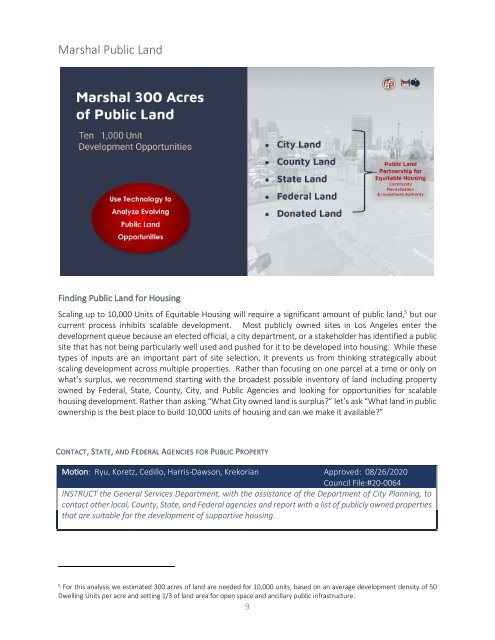SCALING UP Equitable Housing on public land in Los Angeles
A plan to build 10,000 units of housing on public land in Los Angeles
A plan to build 10,000 units of housing on public land in Los Angeles
You also want an ePaper? Increase the reach of your titles
YUMPU automatically turns print PDFs into web optimized ePapers that Google loves.
Marshal Public Land<br />
F<strong>in</strong>d<strong>in</strong>g Public Land for <str<strong>on</strong>g>Hous<strong>in</strong>g</str<strong>on</strong>g><br />
Scal<strong>in</strong>g up to 10,000 Units of <str<strong>on</strong>g>Equitable</str<strong>on</strong>g> <str<strong>on</strong>g>Hous<strong>in</strong>g</str<strong>on</strong>g> will require a significant amount of <strong>public</strong> <strong>land</strong>, 5 but our<br />
current process <strong>in</strong>hibits scalable development. Most <strong>public</strong>ly owned sites <strong>in</strong> <strong>Los</strong> <strong>Angeles</strong> enter the<br />
development queue because an elected official, a city department, or a stakeholder has identified a <strong>public</strong><br />
site that has not be<strong>in</strong>g particularly well used and pushed for it to be developed <strong>in</strong>to hous<strong>in</strong>g. While these<br />
types of <strong>in</strong>puts are an important part of site selecti<strong>on</strong>, it prevents us from th<strong>in</strong>k<strong>in</strong>g strategically about<br />
scal<strong>in</strong>g development across multiple properties. Rather than focus<strong>in</strong>g <strong>on</strong> <strong>on</strong>e parcel at a time or <strong>on</strong>ly <strong>on</strong><br />
what’s surplus, we recommend start<strong>in</strong>g with the broadest possible <strong>in</strong>ventory of <strong>land</strong> <strong>in</strong>clud<strong>in</strong>g property<br />
owned by Federal, State, County, City, and Public Agencies and look<strong>in</strong>g for opportunities for scalable<br />
hous<strong>in</strong>g development. Rather than ask<strong>in</strong>g “What City owned <strong>land</strong> is surplus?” let’s ask “What <strong>land</strong> <strong>in</strong> <strong>public</strong><br />
ownership is the best place to build 10,000 units of hous<strong>in</strong>g and can we make it available?”<br />
CONTACT, STATE, AND FEDERAL AGENCIES FOR PUBLIC PROPERTY<br />
Moti<strong>on</strong>: Ryu, Koretz, Cedillo, Harris-Daws<strong>on</strong>, Krekorian Approved: 08/26/2020<br />
Council File:#20-0064<br />
INSTRUCT the General Services Department, with the assistance of the Department of City Plann<strong>in</strong>g, to<br />
c<strong>on</strong>tact other local, County, State, and Federal agencies and report with a list of <strong>public</strong>ly owned properties<br />
that are suitable for the development of supportive hous<strong>in</strong>g.<br />
5 For this analysis we estimated 300 acres of <strong>land</strong> are needed for 10,000 units, based <strong>on</strong> an average development density of 50<br />
Dwell<strong>in</strong>g Units per acre and sett<strong>in</strong>g 1/3 of <strong>land</strong> area for open space and ancillary <strong>public</strong> <strong>in</strong>frastructure.<br />
9



